Shijie Zhao
Region-Adaptive Video Sharpening via Rate-Perception Optimization
Aug 12, 2025Abstract:Sharpening is a widely adopted video enhancement technique. However, uniform sharpening intensity ignores texture variations, degrading video quality. Sharpening also increases bitrate, and there's a lack of techniques to optimally allocate these additional bits across diverse regions. Thus, this paper proposes RPO-AdaSharp, an end-to-end region-adaptive video sharpening model for both perceptual enhancement and bitrate savings. We use the coding tree unit (CTU) partition mask as prior information to guide and constrain the allocation of increased bits. Experiments on benchmarks demonstrate the effectiveness of the proposed model qualitatively and quantitatively.
Adaptive High-Frequency Preprocessing for Video Coding
Aug 12, 2025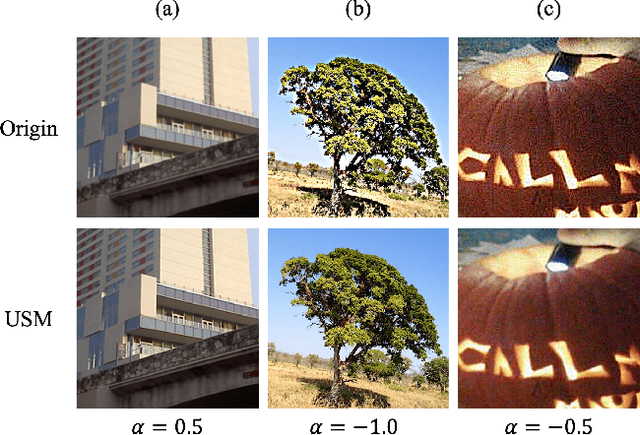

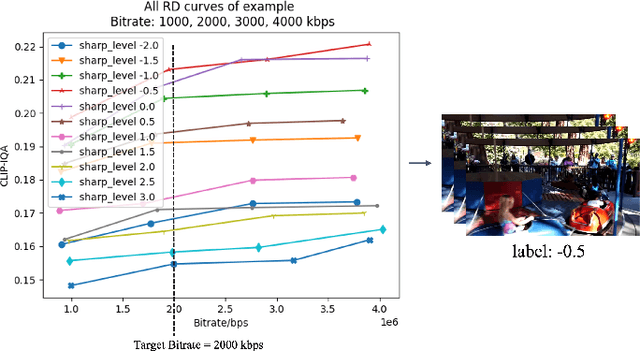
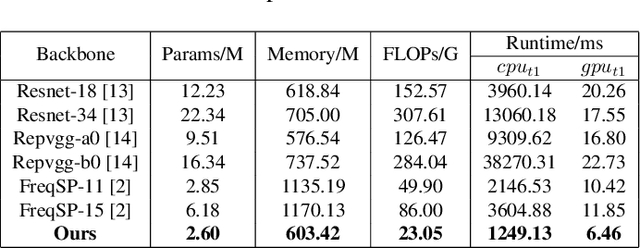
Abstract:High-frequency components are crucial for maintaining video clarity and realism, but they also significantly impact coding bitrate, resulting in increased bandwidth and storage costs. This paper presents an end-to-end learning-based framework for adaptive high-frequency preprocessing to enhance subjective quality and save bitrate in video coding. The framework employs the Frequency-attentive Feature pyramid Prediction Network (FFPN) to predict the optimal high-frequency preprocessing strategy, guiding subsequent filtering operators to achieve the optimal tradeoff between bitrate and quality after compression. For training FFPN, we pseudo-label each training video with the optimal strategy, determined by comparing the rate-distortion (RD) performance across different preprocessing types and strengths. Distortion is measured using the latest quality assessment metric. Comprehensive evaluations on multiple datasets demonstrate the visually appealing enhancement capabilities and bitrate savings achieved by our framework.
Frequency-Assisted Adaptive Sharpening Scheme Considering Bitrate and Quality Tradeoff
Aug 12, 2025Abstract:Sharpening is a widely adopted technique to improve video quality, which can effectively emphasize textures and alleviate blurring. However, increasing the sharpening level comes with a higher video bitrate, resulting in degraded Quality of Service (QoS). Furthermore, the video quality does not necessarily improve with increasing sharpening levels, leading to issues such as over-sharpening. Clearly, it is essential to figure out how to boost video quality with a proper sharpening level while also controlling bandwidth costs effectively. This paper thus proposes a novel Frequency-assisted Sharpening level Prediction model (FreqSP). We first label each video with the sharpening level correlating to the optimal bitrate and quality tradeoff as ground truth. Then taking uncompressed source videos as inputs, the proposed FreqSP leverages intricate CNN features and high-frequency components to estimate the optimal sharpening level. Extensive experiments demonstrate the effectiveness of our method.
MIND-Edit: MLLM Insight-Driven Editing via Language-Vision Projection
May 25, 2025Abstract:Recent advances in AI-generated content (AIGC) have significantly accelerated image editing techniques, driving increasing demand for diverse and fine-grained edits. Despite these advances, existing image editing methods still face challenges in achieving high precision and semantic accuracy in complex scenarios. Recent studies address this issue by incorporating multimodal large language models (MLLMs) into image editing pipelines. However, current MLLM-based methods mainly rely on interpreting textual instructions, leaving the intrinsic visual understanding of large models largely unexplored, thus resulting in insufficient alignment between textual semantics and visual outcomes. To overcome these limitations, we propose MIND-Edit, an end-to-end image-editing framework integrating pretrained diffusion model with MLLM. MIND-Edit introduces two complementary strategies: (1) a text instruction optimization strategy that clarifies ambiguous user instructions based on semantic reasoning from the MLLM, and (2) an MLLM insight-driven editing strategy that explicitly leverages the intrinsic visual understanding capability of the MLLM to infer editing intent and guide the diffusion process via generated visual embeddings. Furthermore, we propose a joint training approach to effectively integrate both strategies, allowing them to reinforce each other for more accurate instruction interpretation and visually coherent edits aligned with user intent. Extensive experiments demonstrate that MIND-Edit outperforms state-of-the-art image editing methods in both quantitative metrics and visual quality, particularly under complex and challenging scenarios.
NTIRE 2025 Challenge on UGC Video Enhancement: Methods and Results
May 05, 2025Abstract:This paper presents an overview of the NTIRE 2025 Challenge on UGC Video Enhancement. The challenge constructed a set of 150 user-generated content videos without reference ground truth, which suffer from real-world degradations such as noise, blur, faded colors, compression artifacts, etc. The goal of the participants was to develop an algorithm capable of improving the visual quality of such videos. Given the widespread use of UGC on short-form video platforms, this task holds substantial practical importance. The evaluation was based on subjective quality assessment in crowdsourcing, obtaining votes from over 8000 assessors. The challenge attracted more than 25 teams submitting solutions, 7 of which passed the final phase with source code verification. The outcomes may provide insights into the state-of-the-art in UGC video enhancement and highlight emerging trends and effective strategies in this evolving research area. All data, including the processed videos and subjective comparison votes and scores, is made publicly available at https://github.com/msu-video-group/NTIRE25_UGC_Video_Enhancement.
Prefill-Based Jailbreak: A Novel Approach of Bypassing LLM Safety Boundary
Apr 28, 2025Abstract:Large Language Models (LLMs) are designed to generate helpful and safe content. However, adversarial attacks, commonly referred to as jailbreak, can bypass their safety protocols, prompting LLMs to generate harmful content or reveal sensitive data. Consequently, investigating jailbreak methodologies is crucial for exposing systemic vulnerabilities within LLMs, ultimately guiding the continuous implementation of security enhancements by developers. In this paper, we introduce a novel jailbreak attack method that leverages the prefilling feature of LLMs, a feature designed to enhance model output constraints. Unlike traditional jailbreak methods, the proposed attack circumvents LLMs' safety mechanisms by directly manipulating the probability distribution of subsequent tokens, thereby exerting control over the model's output. We propose two attack variants: Static Prefilling (SP), which employs a universal prefill text, and Optimized Prefilling (OP), which iteratively optimizes the prefill text to maximize the attack success rate. Experiments on six state-of-the-art LLMs using the AdvBench benchmark validate the effectiveness of our method and demonstrate its capability to substantially enhance attack success rates when combined with existing jailbreak approaches. The OP method achieved attack success rates of up to 99.82% on certain models, significantly outperforming baseline methods. This work introduces a new jailbreak attack method in LLMs, emphasizing the need for robust content validation mechanisms to mitigate the adversarial exploitation of prefilling features. All code and data used in this paper are publicly available.
The Tenth NTIRE 2025 Efficient Super-Resolution Challenge Report
Apr 14, 2025Abstract:This paper presents a comprehensive review of the NTIRE 2025 Challenge on Single-Image Efficient Super-Resolution (ESR). The challenge aimed to advance the development of deep models that optimize key computational metrics, i.e., runtime, parameters, and FLOPs, while achieving a PSNR of at least 26.90 dB on the $\operatorname{DIV2K\_LSDIR\_valid}$ dataset and 26.99 dB on the $\operatorname{DIV2K\_LSDIR\_test}$ dataset. A robust participation saw \textbf{244} registered entrants, with \textbf{43} teams submitting valid entries. This report meticulously analyzes these methods and results, emphasizing groundbreaking advancements in state-of-the-art single-image ESR techniques. The analysis highlights innovative approaches and establishes benchmarks for future research in the field.
Q-Insight: Understanding Image Quality via Visual Reinforcement Learning
Mar 28, 2025



Abstract:Image quality assessment (IQA) focuses on the perceptual visual quality of images, playing a crucial role in downstream tasks such as image reconstruction, compression, and generation. The rapid advancement of multi-modal large language models (MLLMs) has significantly broadened the scope of IQA, moving toward comprehensive image quality understanding that incorporates content analysis, degradation perception, and comparison reasoning beyond mere numerical scoring. Previous MLLM-based methods typically either generate numerical scores lacking interpretability or heavily rely on supervised fine-tuning (SFT) using large-scale annotated datasets to provide descriptive assessments, limiting their flexibility and applicability. In this paper, we propose Q-Insight, a reinforcement learning-based model built upon group relative policy optimization (GRPO), which demonstrates strong visual reasoning capability for image quality understanding while requiring only a limited amount of rating scores and degradation labels. By jointly optimizing score regression and degradation perception tasks with carefully designed reward functions, our approach effectively exploits their mutual benefits for enhanced performance. Extensive experiments demonstrate that Q-Insight substantially outperforms existing state-of-the-art methods in both score regression and degradation perception tasks, while exhibiting impressive zero-shot generalization to comparison reasoning tasks. Code will be available at https://github.com/lwq20020127/Q-Insight.
GenDR: Lightning Generative Detail Restorator
Mar 09, 2025Abstract:Recent research applying text-to-image (T2I) diffusion models to real-world super-resolution (SR) has achieved remarkable success. However, fundamental misalignments between T2I and SR targets result in a dilemma between inference speed and detail fidelity. Specifically, T2I tasks prioritize multi-step inversion to synthesize coherent outputs aligned with textual prompts and shrink the latent space to reduce generating complexity. Contrariwise, SR tasks preserve most information from low-resolution input while solely restoring high-frequency details, thus necessitating sufficient latent space and fewer inference steps. To bridge the gap, we present a one-step diffusion model for generative detail restoration, GenDR, distilled from a tailored diffusion model with larger latent space. In detail, we train a new SD2.1-VAE16 (0.9B) via representation alignment to expand latent space without enlarging the model size. Regarding step-distillation, we propose consistent score identity distillation (CiD) that incorporates SR task-specific loss into score distillation to leverage more SR priors and align the training target. Furthermore, we extend CiD with adversarial learning and representation alignment (CiDA) to enhance perceptual quality and accelerate training. We also polish the pipeline to achieve a more efficient inference. Experimental results demonstrate that GenDR achieves state-of-the-art performance in both quantitative metrics and visual fidelity.
Spatial Degradation-Aware and Temporal Consistent Diffusion Model for Compressed Video Super-Resolution
Feb 12, 2025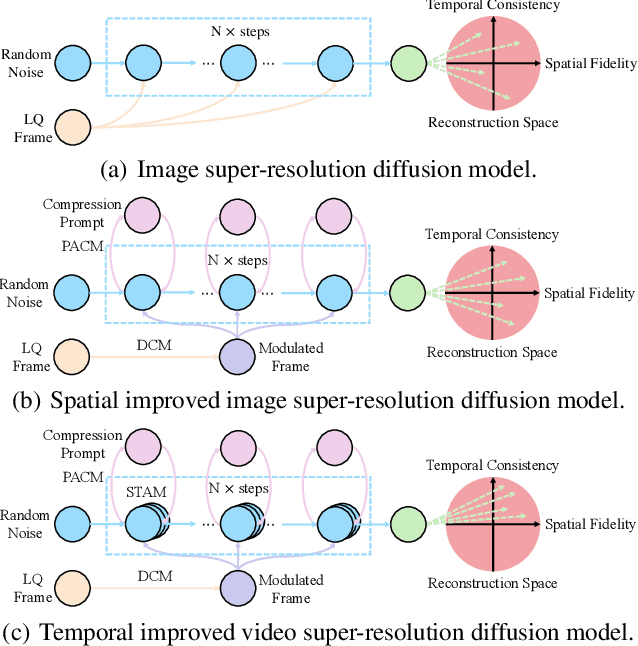
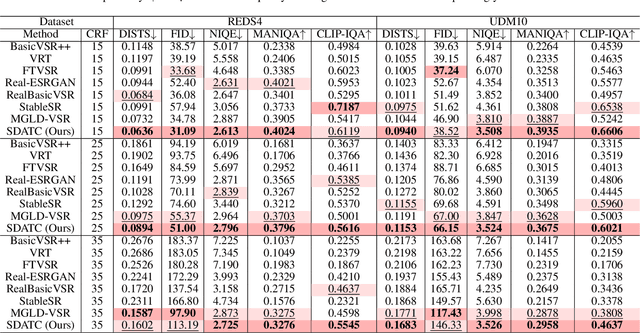
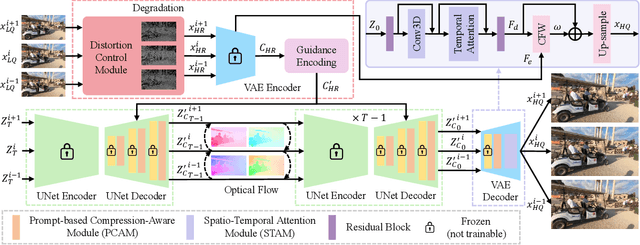

Abstract:Due to limitations of storage and bandwidth, videos stored and transmitted on the Internet are usually low-quality with low-resolution and compression noise. Although video super-resolution (VSR) is an efficient technique to enhance video resolution, relatively VSR methods focus on compressed videos. Directly applying general VSR approaches leads to the failure of improving practical videos, especially when frames are highly compressed at a low bit rate. Recently, diffusion models have achieved superior performance in low-level visual tasks, and their high-realism generation capability enables them to be applied in VSR. To synthesize more compression-lost details and refine temporal consistency, we propose a novel Spatial Degradation-Aware and Temporal Consistent (SDATC) diffusion model for compressed VSR. Specifically, we introduce a distortion Control module (DCM) to modulate diffusion model inputs and guide the generation. Next, the diffusion model executes the denoising process for texture generation with fine-tuned spatial prompt-based compression-aware module (PCAM) and spatio-temporal attention module (STAM). PCAM extracts features to encode specific compression information dynamically. STAM extends the spatial attention mechanism to a spatio-temporal dimension for capturing temporal correlation. Extensive experimental results on benchmark datasets demonstrate the effectiveness of the proposed modules in enhancing compressed videos.
 Add to Chrome
Add to Chrome Add to Firefox
Add to Firefox Add to Edge
Add to Edge